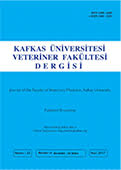
This journal is licensed under a Creative Commons Attribution-NonCommercial 4.0 International License
Kafkas Üniversitesi Veteriner Fakültesi Dergisi
2017 , Vol 23 , Issue 6
Light and Scanning Electron Microscopic Structure of the Pecten Oculi in the Common Barn Owl (Tyto alba)
1Department of Anatomy, Faculty of Veterinary Medicine, Harran University, TR-63300 Sanliurfa - TURKEY2Department of Histology and Embryology, Faculty of Veterinary Medicine, Harran University, TR-63300 Sanliurfa - TURKEY
3Department of Anatomy, Faculty of Veterinary Medicine, Erciyes University, TR-38039 Kayseri - TURKEY
4Department of Anatomy, Faculty of Medicine, Kafkas University, TR-36100 Kars - TURKEY
5Department of Anatomy, Faculty of Veterinary Medicine, Ankara University, TR-06110 Ankara - TURKEY DOI : 10.9775/kvfd.2017.18070 This study was carried out to investigate the structural properties of pecten oculi in the common barn owl (Tyto alba) by light and electron microscope. Fourteen eyeballs from seven owls were studied. The pecten oculi was located postero-anteriorly in the retina layer where the optic nerve enters the eye. The pecten oculi that was dark brown and pleated type consisted of 7 (n=4) or 8 (n=10) vascularised pectineal pleats. Histologically, there were numerous vessels of different size and melanocytes in the area of the pleats. Melanocytes were more frequently observed in the periphery of the pecten oculi"s pleats. Scanning electron microscopy showed hyalocytes on the surface of the pecten oculi. The results of the study indicated that the pecten oculi of the common barn owl was morphologically similar to that of other nocturnal birds. Keywords : Common barn owl, Pecten oculi, Tyto alba, SEM










